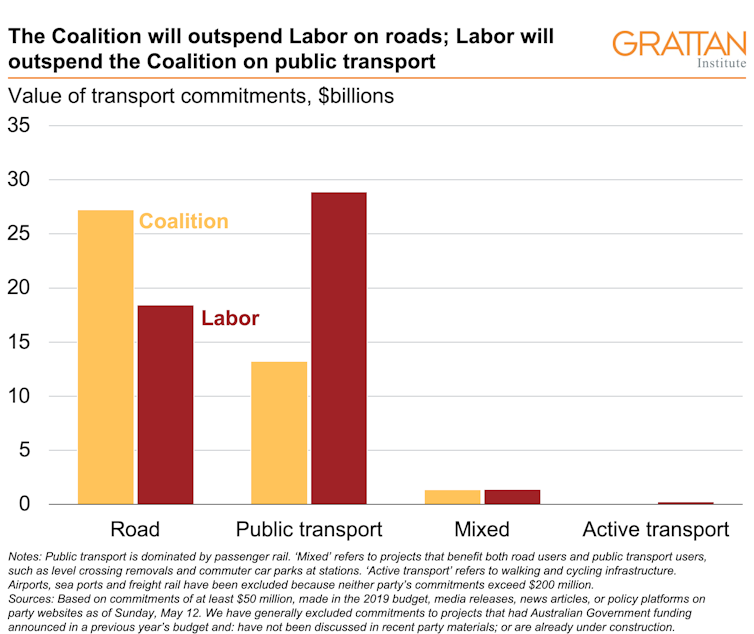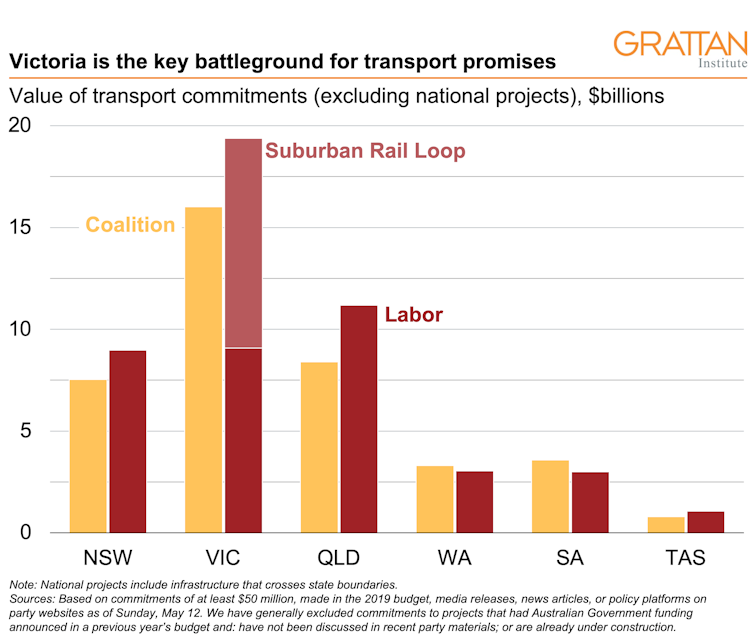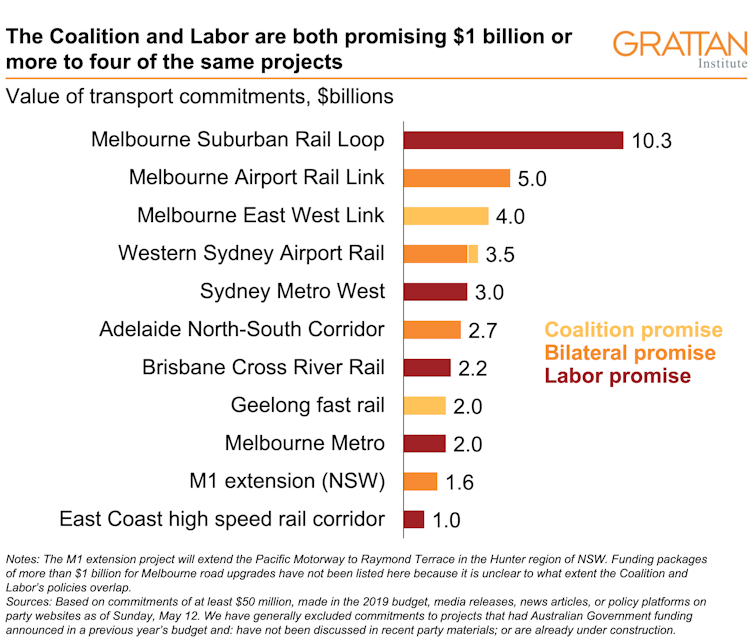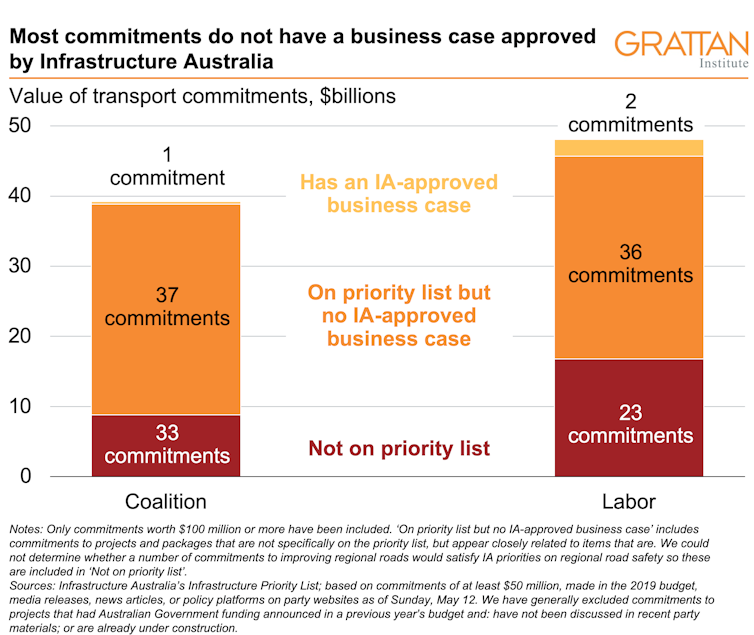Transport promises for election 2019: the good, the bad and the downright ugly
- Written by Greg Moran, Senior Associate, Grattan Institute
No matter who wins Saturday’s federal election, you can expect to see more cranes on the skyline and hi-viz vests on the roadside. Both major parties are promising to spend big on transport infrastructure: A$42 billion for the Coalition and A$49 billion for Labor. However, many of the favoured projects are unlikely to be completed for years or even decades to come.
Read more: We hardly ever trust big transport announcements – here's how politicians get it right
What’s being promised, and where?
The types of project each party is promising reflect a now-familiar pattern seen in the recent Victorian and New South Wales elections. The Coalition will outspend Labor on roads; Labor will outspend the Coalition on public transport.
 Author provided
There’s also a story in the details of where the parties are promising to spend. In Victoria, where the Coalition suffered heavy losses in last October’s state election, the federal Coalition has been busy “sandbagging” key seats. Until last weekend, the Coalition had been promising much more than Labor.
Announcements on Sunday changed all that. While the Coalition upped its commitment to the East West Link to A$4 billion, this was dwarfed by Labor’s A$10 billion pledge for the Suburban Rail Loop. Victoria now stands as the key battleground for transport promises.
Read more:
East-West Link shows miserable failure of planning process
Labor is also writing bigger cheques than the Coalition in Queensland, where it hopes to make big gains.
Author provided
There’s also a story in the details of where the parties are promising to spend. In Victoria, where the Coalition suffered heavy losses in last October’s state election, the federal Coalition has been busy “sandbagging” key seats. Until last weekend, the Coalition had been promising much more than Labor.
Announcements on Sunday changed all that. While the Coalition upped its commitment to the East West Link to A$4 billion, this was dwarfed by Labor’s A$10 billion pledge for the Suburban Rail Loop. Victoria now stands as the key battleground for transport promises.
Read more:
East-West Link shows miserable failure of planning process
Labor is also writing bigger cheques than the Coalition in Queensland, where it hopes to make big gains.
 Author provided
There’s some agreement on the big stuff
Despite their different ideologies and at-risk electorates, there is still much common ground between the parties. Almost one in three of the projects and funding packages that have attracted promises of at least A$50 million are backed by both the Coalition and Labor. Each party has promised almost A$24 billion for these “bilateral” projects – that’s more than half of the Coalition’s total promised transport infrastructure spending and almost half of Labor’s.
The parties are more likely to agree on big projects than small. Bilateral commitments make up almost half of all promises worth at least A$500 million, but less than a third of those below that threshold. For the very largest projects, the level of agreement is somewhere in between – the Coalition and Labor agree on four of the 11 projects attracting commitments of more than A$1 billion.
Author provided
There’s some agreement on the big stuff
Despite their different ideologies and at-risk electorates, there is still much common ground between the parties. Almost one in three of the projects and funding packages that have attracted promises of at least A$50 million are backed by both the Coalition and Labor. Each party has promised almost A$24 billion for these “bilateral” projects – that’s more than half of the Coalition’s total promised transport infrastructure spending and almost half of Labor’s.
The parties are more likely to agree on big projects than small. Bilateral commitments make up almost half of all promises worth at least A$500 million, but less than a third of those below that threshold. For the very largest projects, the level of agreement is somewhere in between – the Coalition and Labor agree on four of the 11 projects attracting commitments of more than A$1 billion.
 Author provided
But voters are forced to make risky choices, again
With so much cash on the table, will these vast riches be spent on the right things?
More money for roads and public transport probably sounds fine to most Australians, whether they’re navigating potholed rural roads, stuck behind trucks on regional highways, drumming the steering wheel in clogged city streets, or calling in late on delayed suburban trains.
Read more:
Congestion-busting infrastructure plays catch-up on long-neglected needs
But are the projects of national significance and therefore worthy of Commonwealth attention? And can they be relied on to return a benefit larger than their cost?
For too many projects, the answers are no and no. Infrastructure Australia (IA) publishes a list of national priorities and evaluates business cases for projects that are “nationally significant or where Commonwealth funding of A$100 million or more is sought”. Most of the commitments above A$100 million in this campaign do not have IA-approved business cases.
Some projects are under evaluation, such as a new bridge in Nowra on the NSW south coast, but the two parties should have waited for IA’s assessment before committing.
Worse still, many promised projects are not even on the national priority list.
Author provided
But voters are forced to make risky choices, again
With so much cash on the table, will these vast riches be spent on the right things?
More money for roads and public transport probably sounds fine to most Australians, whether they’re navigating potholed rural roads, stuck behind trucks on regional highways, drumming the steering wheel in clogged city streets, or calling in late on delayed suburban trains.
Read more:
Congestion-busting infrastructure plays catch-up on long-neglected needs
But are the projects of national significance and therefore worthy of Commonwealth attention? And can they be relied on to return a benefit larger than their cost?
For too many projects, the answers are no and no. Infrastructure Australia (IA) publishes a list of national priorities and evaluates business cases for projects that are “nationally significant or where Commonwealth funding of A$100 million or more is sought”. Most of the commitments above A$100 million in this campaign do not have IA-approved business cases.
Some projects are under evaluation, such as a new bridge in Nowra on the NSW south coast, but the two parties should have waited for IA’s assessment before committing.
Worse still, many promised projects are not even on the national priority list.
 Author provided
For projects attracting commitments of less than A$100 million, most are best left to state governments. The Commonwealth should stick to projects that are important to more than one state or are particularly important to the national economy.
Fixing regional and suburban intersections is important, but it’s hardly of national significance. When federal parties get involved, it starts to smell like pork-barrelling.
Read more:
Missing evidence base for big calls on infrastructure costs us all
Some promises are inexcusable
Throwing taxpayer money at boondoggles is poor governance. Far worse is flagrantly ignoring independent advice and burning cash on projects that we know don’t stack up. Before the 2016 federal election, Grattan Institute reported on the outrageous Princes Highway duplication between Winchelsea and Colac in Victoria’s Western District. The Coalition promised this project even though IA determined that it would return only eight cents of value for every dollar spent.
Three years on, lessons still need to be learnt. Labor has committed A$50 million this election to the Maldon-Dombarton rail link in NSW’s Illawarra region. This A$806 million project got the thumbs-down in 2017 from IA, which stated that “the project would not justify its costs and would impose a net cost on the Australian economy”.
In exceptional cases, governments may want to fund projects with costs outweighing benefits on equity grounds, such as to provide a minimum level of service for rural communities. It is hard to make that case for a commercial freight rail link.
Every dud project built cannibalises a worthy one. Our politicians should stop donning hardhats and promising infrastructure before they’ve done their homework.
Author provided
For projects attracting commitments of less than A$100 million, most are best left to state governments. The Commonwealth should stick to projects that are important to more than one state or are particularly important to the national economy.
Fixing regional and suburban intersections is important, but it’s hardly of national significance. When federal parties get involved, it starts to smell like pork-barrelling.
Read more:
Missing evidence base for big calls on infrastructure costs us all
Some promises are inexcusable
Throwing taxpayer money at boondoggles is poor governance. Far worse is flagrantly ignoring independent advice and burning cash on projects that we know don’t stack up. Before the 2016 federal election, Grattan Institute reported on the outrageous Princes Highway duplication between Winchelsea and Colac in Victoria’s Western District. The Coalition promised this project even though IA determined that it would return only eight cents of value for every dollar spent.
Three years on, lessons still need to be learnt. Labor has committed A$50 million this election to the Maldon-Dombarton rail link in NSW’s Illawarra region. This A$806 million project got the thumbs-down in 2017 from IA, which stated that “the project would not justify its costs and would impose a net cost on the Australian economy”.
In exceptional cases, governments may want to fund projects with costs outweighing benefits on equity grounds, such as to provide a minimum level of service for rural communities. It is hard to make that case for a commercial freight rail link.
Every dud project built cannibalises a worthy one. Our politicians should stop donning hardhats and promising infrastructure before they’ve done their homework.
Authors: Greg Moran, Senior Associate, Grattan Institute





